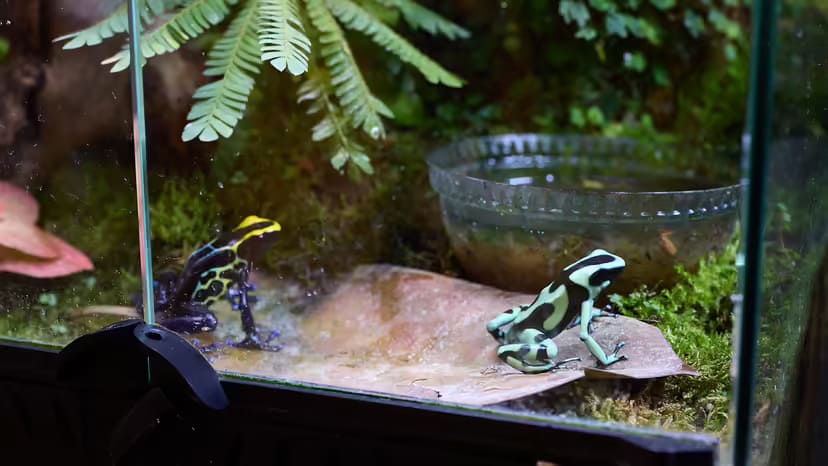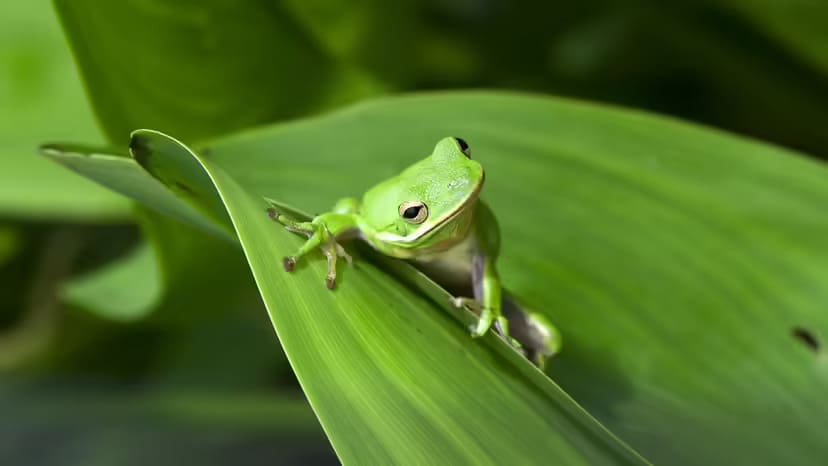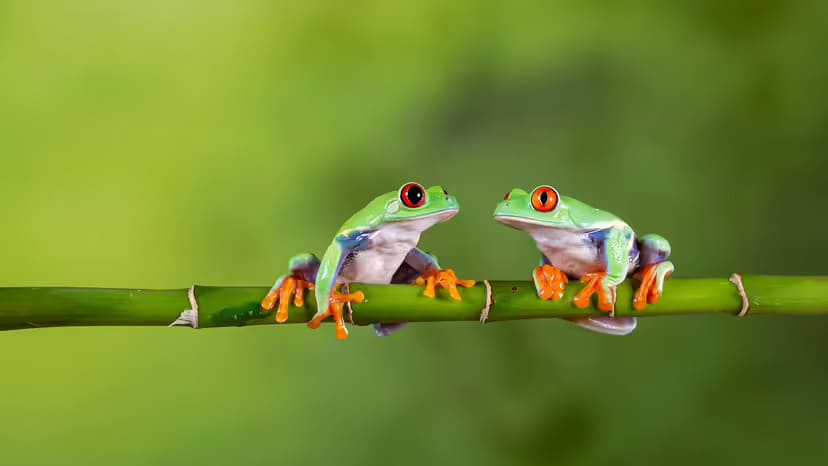Want a pet that doesn’t need walks, sheds little to no hair, and turns a glass box into living art? Frogs are a great fit. As amphibians, they come in stunning shapes and colors and—once the habitat is set up correctly—most species are low-maintenance, highly observable companions.
Unlike dogs or cats, frogs won’t fetch or snuggle, but they excel at quiet, quirky behavior and night-time activity. From neon-green tree frogs to tomato-red terrestrial species, a well-designed vivarium becomes a vibrant, ever-changing display.

Why Frogs Make Excellent Pets
Habitat Setup: Re-creating Nature Indoors
Diet: Live Foods and Supplementation
Handling & Health: Amphibian-specific Care
8 Popular Pet Frogs (Beginner → Advanced)
Buying, Quarantine & Co-housing Rules
Common Risks & Rookie Mistakes
13 Practical Tips for Frog Owners
Budget & Time Estimates (optional)
Quiet, easy to observe: Most species are calm and low-noise—great for apartments.
Smaller space needs: Many frogs require less room than typical reptiles or small mammals.
Rule of habitat: Arboreal, terrestrial, semi-aquatic, and fully aquatic frogs thrive when temperature, humidity, ventilation, and layout mirror their native biome.
Visual variety: Eye-catching colors and forms—from emerald greens to fiery oranges.
Captive-bred availability: Most common pet species are captive-bred, which typically means healthier animals better adapted to life in a terrarium.

Golden rule: build around the species’ ecology. Get temperature, humidity, water quality, ventilation, and structure right—and stability follows.
Tank: Locking glass terrarium/aquarium (tall for tree frogs, wide for ground dwellers).
Monitoring: Thermometer + hygrometer. Add heat mat/ceramic heater with a thermostat if needed.
Ventilation: Cross-vent (top + side) to prevent stale, damp air and skin issues.
Lighting: 10–12 hr day/night cycle. Most frogs don’t need strong UVB; low UVB can aid calcium metabolism (research for your species).
Terrestrial/arboreal: Coco fiber/peat mix with bark chips and leaf litter—moist but not waterlogged; add cork tubes, branches, vines, and hides.
Semi-aquatic: Land-to-water ratio ~1:1 or 2:1; create a shallow shore and gentle ramp.
Aquatic: Sponge or canister filtration; smooth river stones or fine sand (use stones too large to swallow).
Live plants: Ferns, pothos, and bromeliads help stabilize humidity, absorb waste, and provide cover.
Bioactive option: Springtails/Isopods + leaf litter can help process waste and reduce odors.
Temperature: 72–82 °F (22–28 °C), with a mild night drop.
Humidity: 60–90% depending on species (tree frogs generally higher; ground dwellers prefer moist substrate + relatively drier surface air).
Water: Dechlorinated or RO-remineralized. Aquatics need consistent filtration and partial changes.
Maintenance: Daily misting as needed; spot-clean waste; weekly light service; monthly deep clean/substrate refresh (bioactive setups can extend intervals).
Frogs are carnivores and respond to movement.
Staples
Crickets, houseflies, moths, small roaches
Mealworms/superworms (treats; higher fat)
Waxworms (high fat; sparingly)
Earthworms (favorites for many terrestrial species)
Aquatic: bloodworms, brine shrimp, daphnia (watch water quality)
Feeding Frequency
Juveniles: daily, small amounts
Adults: every 2–3 days (adjust to body condition and feces quality)
Supplements
Calcium powder: 2–3×/week light dusting
Multivitamin (with D3): ~1×/week
Rotate prey items to prevent deficiencies and picky eating.
Never use wild-caught insects (pesticide/parasite risk).
Minimal handling: Frog skin is highly permeable; avoid soaps, lotions, and disinfectants. If you must move a frog, rinse hands with dechlorinated water or wear moistened gloves.
Red flags
Poor appetite or refusal to eat
Abnormal skin color/texture, sores, cottony growth
Swollen limbs, bloat, unsteady floating
Lethargy or daytime inactivity far beyond normal
Diarrhea or unusual feces
Likely causes: Wrong temp/humidity, dirty water, narrow diet, or micronutrient gaps.
Vet care: Seek a veterinarian experienced with reptiles/amphibians. Bring notes on temperatures, humidity, last feed, and fecal appearance.

(Still research your exact species before buying—parameters vary by locale and morph.)
American Green Tree Frog (Beginner, arboreal)
75–80 °F, 70–90% RH; tall tank with branches. Lively, classic bright green.
Dart Frogs (Dendrobatidae) (Intermediate, forest floor)
72–78 °F, high humidity, dense planted vivarium. Nontoxic in captivity; dazzling colors.
White’s Tree Frog (Dumpy/Blue-green) (Beginner→Intermediate, arboreal)
75–80 °F, 60–80% RH; forgiving and personable, great for first tree frog.
Pacman Frog (Ceratophrys) (Beginner→Intermediate, terrestrial ambush)
75–82 °F; deep, moist substrate; big appetite—control portions to prevent obesity/fatty liver.
Red-eyed Tree Frog (Intermediate, arboreal)
75–80 °F, high humidity with good ventilation; iconic nocturnal display.
African Bullfrog (Pixie Frog) (Advanced, terrestrial)
78–82 °F; robust, large, heavy feeders; best for experienced keepers.
Tomato Frog (Intermediate, terrestrial)
75–80 °F; moist leaf-litter substrate; may secrete sticky mucus when stressed—limit disturbance.
Oriental Fire-bellied Toad (Beginner, semi-aquatic)
68–75 °F; land–water split with shallow pool; hardy, striking warning colors.
Choose captive-bred animals only: Healthier, legal, and more ethical; avoid wild-caught frogs.
No mixed species: Different temperature/humidity needs and sizes lead to stress or predation. Many frogs will eat smaller tank mates—including other frogs.
Do not co-house with reptiles or fish: Conflicting parameters and pathogen risks.
Quarantine: Isolate new frogs 2–4 weeks. Confirm eating, defecating, and normal behavior before housing with conspecifics.
Watching temperature but ignoring humidity and ventilation (skin issues, mold).
Feeding one prey item for months—nutritional gaps follow.
Using untreated tap water—chlorine/chloramine irritate eyes/skin.
Over-handling and dry hands—damages the skin barrier.
“Looks clean, so I won’t clean”—ammonia and nitrites build up fast.
Mixing species or size classes “because they look alike.”
Buying a tank first, choosing the species later (reverse it: pick species → build to spec).
Match enclosure type (tall/long, terrestrial/aquatic) to the species.
Use a reliable thermometer and hygrometer—check daily.
Plant the tank; live greens stabilize humidity and provide cover.
Avoid handling unless necessary.
Observe feeding, body condition, and night activity.
Use dechlorinated or RO-remineralized water only.
Create thermal and humidity gradients so frogs can self-regulate.
Store feeders properly; dust with calcium/vitamins as scheduled.
Keep substrate moist but not waterlogged; fluff and turn leaf litter.
Spot-clean leftovers and feces promptly.
Provide hides, branches, and microhabitats to encourage natural behaviors.
Buy from reputable breeders/stores selling captive-bred frogs.
If keeping multiples, use the same species and similar sizes; watch for bullying.
One-time setup: Terrarium, lighting, heat/thermostat, misting bottle/system, substrate, plants, decor, water treatment—entry-level to mid-range varies widely by size and gear.
Monthly costs: Live feeders, supplements, substrate refresh, water and consumables.
Time: 5–10 min/day (misting/observation), 20–30 min/week (tidy/spot-clean), monthly deep service.
Frogs reward a “look more, handle less” approach. Invest your care into environment and hygiene, and they’ll repay you with natural behaviors, vivid colors, and a slice of rainforest or wetland right on your desk. Choose the species first, build the habitat around its needs, and keep to simple routines—you’ll have a vibrant, living display that’s as relaxing as it is educational.
animal tags: pet frogs
We created this article in conjunction with AI technology, then made sure it was fact-checked and edited by a Animals Top editor.